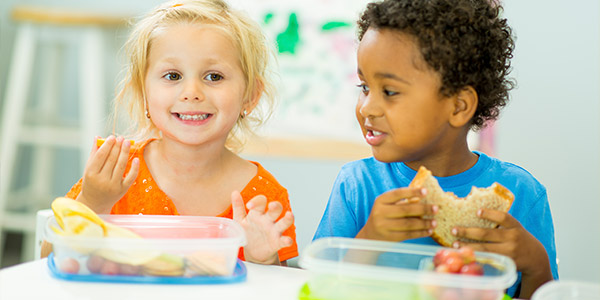Healthy Lunches for Kids
For many parents, packing their children’s lunches and snacks can feel like guesswork. Will they eat it, or not? Packing sugary, unhealthy items may often seem like the only way to make sure they eat something during the school day. Manisha Panchal, M.D., a pediatrician at the Palo Alto Medical Foundation, sees many parents in this predicament. Her advice? Don’t give up on healthy foods just yet. A few simple tricks are all it takes to create healthy school lunches you and your kids will love.
“Don’t give up on healthy foods, even if your children don’t always return from school with an empty lunch box,” she says. “The preschool and elementary school years are a critical time to help children learn healthy eating habits for life.”

Keep it Simple
Dr. Panchal advises using the five food groups (fruits, vegetables, grains, protein and dairy) as your guide. Including an item from each of these groups in your child’s lunch box will help ensure a balanced meal. For example, you might pack an apple, carrot sticks, whole-grain crackers, a cheese stick and a handful of unsalted nuts (as appropriate for your child).
“Getting children to eat fruits and vegetables at lunch is tough,” Dr. Panchal says. “To make these foods more inviting, cut them up into snack-size small pieces. Fruit such as apples, pears, mandarin oranges, grapes or berries are really nature’s candy. They make great portable snacks and can satisfy cravings for something sweet. Choose what’s in season, which is when it tastes best.”
At the same time as you add natural sweets, nix the sugary snacks, she adds. “Don’t think you always have to include a cookie or a piece of candy – these items should be an occasional treat,” she says.
Foods that Satisfy
Give your child the fuel to do his or her personal best by packing in the protein. Protein provides sustained energy and helps maintain blood sugar levels.
“That way your child won’t get hungry again too soon and will be able to function well at school,” Dr. Panchal says.
Good choices include cheese sticks, hummus, egg slices or nuts. For example, a high-quality snack might be an apple with some cheese cubes or nut butter, veggie sticks with hummus or a small handful of dried fruit and nuts.
Peanut butter is another high-protein food, but be sure to check the label. Some peanut butters contain partially hydrogenated fats that can increase “bad” cholesterol (low-density lipoprotein or LDL) and decrease your body’s “good” cholesterol (high-density lipoprotein or HDL). To avoid the hydrogenated fats, you can buy organic peanut butter or an all-peanut spread.
Because children are more likely to eat foods they help make, consider having your child help you make a special trail mix at home, Dr. Panchal advises.
Rethink the Drink
Juices are often sold as being equivalent to fruits and vegetables, but they are not, Dr. Panchal says.
“Stick to water,” she says. “Avoid sugary drinks and juice boxes that pack calories and little else. Get your child into the habit of packing his own reusable water bottle every day. Add a slice of lemon or lime for taste.”
Think Outside the Lunchbox
Finding creative ways to serve and combine foods is another of Dr. Panchal’s tricks for encouraging children to eat healthy. “Use cookie cutters to create fun shapes for sandwiches and fruit, or pack breakfast foods such as pancakes or waffles that your child can dip in applesauce,” she says.
Another simple “thinking outside the lunchbox trick” is to use leftovers from dinner the night before. If your child likes roasted chicken or turkey, set aside a few pieces for lunch the next day. Not only will this make a healthy addition to your child’s lunch, but it will also save you time.
“Finally, don’t feel like you should say ‘no’ to every treat,” Dr. Panchal says. “This can have the reverse effect and make your child crave what he or she can’t have. Aiming for healthy lunches and snacks five days a week will help make healthy eating more sustainable.”




